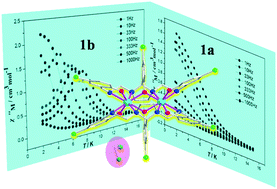Solvent orientation in the crystal lattice producing distinct magnetic dynamics in two binuclear Dy(iii) polymorphs with a polydentate Schiff base ligand†
Abstract
Two Dy(III) polymorphs, [Dy(Clapi)]2·(CH2Cl2)2 (H3Clapi = 2-(2′-hydroxy-5′-chlorophenyl)-1,3-bis[3′-aza-4′-(2′′-hydroxy-5′′-chlorophenyl)prop-4′-en-1′-yl]-1,3-imidazolidine), have been obtained, crystallizing in space groups P21/c (1a) and C2/c (1b), respectively. Both 1a and 1b have an identical eight-coordinated Dy(III) configuration with D4d symmetry; their only difference is the lattice orientation of the solvent molecule CH2Cl2. Alternating current (ac) magnetic susceptibility measurements reveal that they exhibit distinct magnetic behaviours. Theoretical calculations indicate that the exchange interactions play a vital role in the magnetic behavior of the polymorphs. This work presents a rational model to explore the magneto-structural relationship in both experimental and theoretical aspects of Dy(III) single-molecule magnets.



 Please wait while we load your content...
Please wait while we load your content...